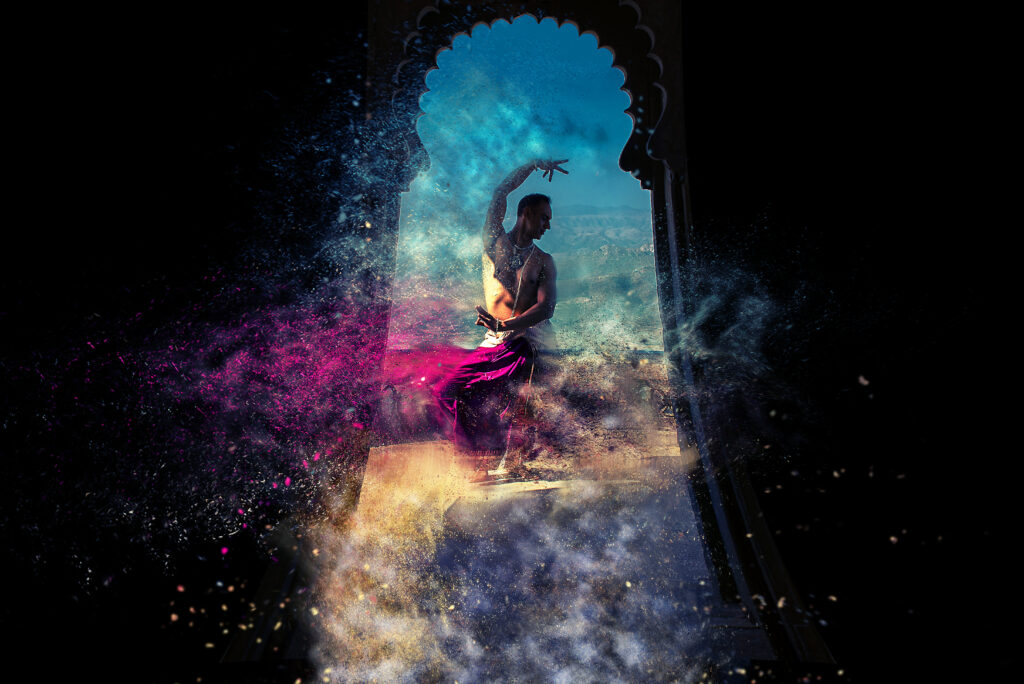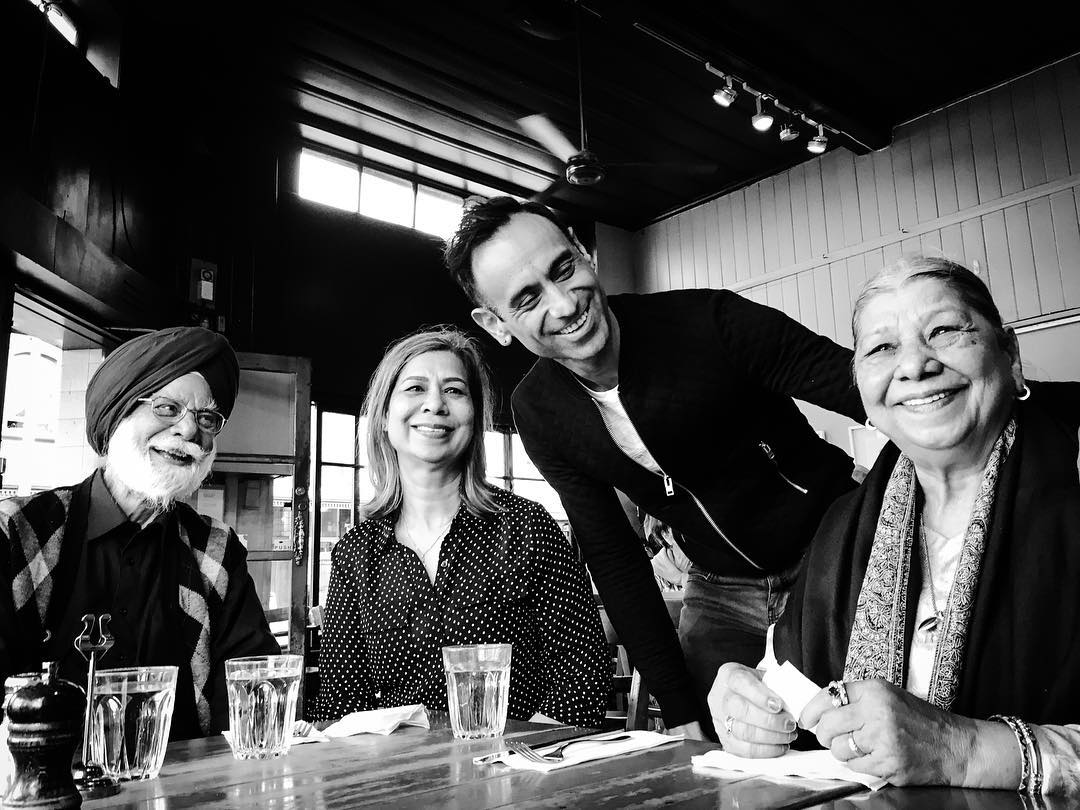

Early Life in Punjab
Sam is born into a working-class Sikh family in rural Punjab. His father works as a truck driver, maintaining traditional values and expectations. Even as a child, Sam shows an affinity for movement and expression that sets him apart.

Discovery of Odissi
A chance encounter with an Odissi performance at a cultural festival awakens something profound in Sam. Despite cultural barriers and family skepticism, he begins secret training in this ancient dance form, finding in it a means of self-expression.

Migration to Melbourne
Seeking acceptance both for his sexual identity and artistic passion, Sam makes the difficult decision to leave his homeland for Australia. With limited resources but boundless determination, he begins building a new life where both aspects of his identity can flourish.

Professional Recognition
Sam’s dedication to Odissi bears fruit as he begins receiving recognition in Melbourne’s cultural scene. His unique perspective as a Sikh artist performing a traditionally Hindu dance form brings new dimensions to his work. He collaborates with celebrated Odissi guru Bichitrananda Swain.

Reconciliation & Acceptance
Sam’s relationship with his family evolves as his father visits Melbourne. Through witnessing his son’s artistry and the respect he commands, a profound transformation occurs in his father, bridging cultural and generational divides with love and understanding.
Thematic Exploration
Delve into the core themes that shape Sam’s journey, exploring the intersections of identity, art, and cultural heritage.
Cultural Identity
The documentary explores the complex relationship between cultural heritage and personal identity. As a Sikh man practicing a classical Hindu dance form, Sam’s journey embodies the fluidity and adaptability of cultural expression. The film examines how traditions can be both constraining and liberating, challenging the notion that cultural identities are fixed or homogeneous.
Through Sam’s story, we witness how ancient art forms can be reinterpreted through contemporary experiences, creating new meanings while honoring their origins. His practice of Odissi becomes a bridge between his Sikh heritage and his artistic expression, demonstrating how individuals can navigate and synthesize seemingly disparate cultural influences to craft authentic identities.
Sexual Identity and Acceptance
The film sensitively portrays the challenges faced by LGBTQI+ individuals in conservative communities, particularly where language itself lacks terminology for diverse sexual identities. Sam’s observation that Punjabi has “no word for gay” becomes a powerful metaphor for the cultural silence surrounding homosexuality.
The documentary follows his search for acceptance—both self-acceptance and from his family—and how art becomes a bridge for communication when words fail. His father’s journey from skepticism to understanding offers a hopeful narrative about the possibility of change and reconciliation across generational and cultural divides. Through dance, Sam finds a vocabulary to express aspects of himself that his mother tongue cannot name.
The Transformative Power of Dance
At its heart, “The Lion Dances” celebrates the expressive and transformative power of Odissi dance. The documentary shows how this ancient art form, with its rich history of storytelling and spiritual expression, becomes Sam’s language for communicating complex emotions and experiences.
The film explores how embodied practices can articulate what verbal language cannot, creating spaces for expression beyond cultural and linguistic limitations. Through dance, Sam not only finds his voice but also builds bridges between different aspects of his identity—his Sikh heritage, his sexuality, and his artistic passion. The physical discipline of Odissi becomes a metaphor for the inner strength required to live authentically in the face of societal expectations.
Family Relationships
The evolution of Sam’s relationship with his family, particularly his father, forms a central narrative arc in the documentary. Beginning with disconnection and misunderstanding, the film traces how art can facilitate emotional reconciliation and mutual understanding.
The documentary portrays the complex dynamics within immigrant families, where cultural values, generational differences, and geographical distance create layers of complexity. Through intimate family moments, we witness how love can transcend cultural constraints, allowing for new definitions of family acceptance. His father’s transformation from confusion to pride offers a powerful example of how witnessing a loved one’s authentic self-expression can change deeply held perspectives.
Cultural Context
Explore the cultural elements and traditions that shape Sam’s journey and the documentary’s narrative.
Odissi Dance
An ancient classical dance form from Eastern India
ଓଡିଶୀOdissi Dance
Originating in the temples of Odisha in eastern India, Odissi is one of the eight classical dance forms of India. Dating back to the 2nd century BCE, it was traditionally performed by female temple dancers called Maharis as a form of worship.
Characterized by tribhangi (three-part break) postures, lyrical movements, and elaborate storytelling through intricate gestures (mudras), Odissi embodies themes from Hindu mythology, particularly relating to Lord Jagannath and the incarnations of Vishnu.
Nearly lost during British colonial rule, Odissi experienced a revival in the mid-20th century. Today, it is performed by dancers of all genders worldwide, embracing both tradition and innovation. Its complex expressions of emotion (bhava) and spiritual devotion make it uniquely suited for exploring themes of identity and transformation.
Sikh Heritage
Traditions, values, and community life
ਸਿੱਖSikh Heritage
Sikhism, founded in the 15th century by Guru Nanak in Punjab, is based on principles of equality, justice, and service to humanity. The religion emphasizes the oneness of God and rejects discrimination based on caste, creed, or gender.
Traditional Sikh communities are centered around the gurdwara (temple) and follow the teachings of the Guru Granth Sahib, their holy scripture. Core values include honest living (kirat karo), sharing with others (vand chakko), and remembering God in daily life (naam japna).
While historically progressive in its stance on equality, contemporary Sikh communities vary in their approaches to LGBTQ+ identities. The tension between traditional family expectations and individual expression is experienced differently across urban and rural settings, and between generations.
The global Sikh diaspora maintains strong cultural connections while adapting to new societal contexts, creating dynamic interpretations of tradition and identity.
Beyond Words
When art speaks what language cannot
表現Beyond Words
Throughout history, art forms have provided expression where verbal language proves inadequate. For marginalized communities, artistic expression often becomes a vital means of communication and resistance.
In many traditional societies, direct discussion of sexuality remains taboo, leaving significant gaps in language. As Sam notes, Punjabi lacks terminology for gay identity, creating a linguistic void that art can fill.
Dance, with its embodied expression, has a unique capacity to transcend cultural and linguistic boundaries. The body becomes a vessel for communicating complex emotions and experiences that may otherwise remain unspoken.
For immigrants and diaspora communities, traditional art forms often serve as cultural anchors while simultaneously evolving to reflect new realities. In this transformation, art becomes both a connection to heritage and a pathway to new forms of self-expression.